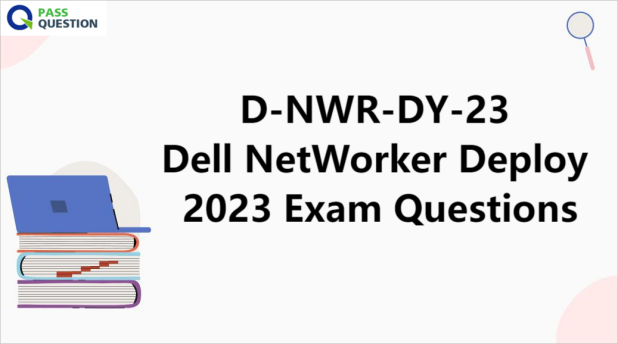
D-NWR-DY-23 Exam Overview - Dell NetWorker Deploy 2023
Are you preparing to take the D-NWR-DY-23 Dell NetWorker Deploy 2023 Exam? If so, you will find that the latest D-NWR-DY-23 Dell NetWorker Deploy 2023 Exam Questions from PassQuestion provide an invaluable resource for your study needs. By using these D-NWR-DY-23 Dell NetWorker Deploy 2023 Exam Questions, you can effectively gauge your comprehension and readiness to sit for the official D-PDM-DY-23 exam. The main goal of our D-NWR-DY-23 Dell NetWorker Deploy 2023 Exam Questions is to provide you with the tools you need to pass your exam with guaranteed success.

The Dell NetWorker Deploy 2023 exam aims to verify individuals' understanding of enterprise backup concepts and their ability to implement Dell NetWorker backup solutions. The exam content encompasses NetWorker Concepts, NetWorker Implementation, NetWorker Administration, and NetWorker Administration - Cloud Enablement. It also includes topics like use cases, system architecture, components, monitoring, maintenance, capacity management, backup, restore, implementation, maintenance, and best practices.
The assessment is split into two sections. The first section lasts for 90 minutes and includes 54 questions, with a required pass mark of 63%. The second section is shorter, with a duration of 30 minutes, and comprises 6 simulation questions, requiring a pass mark of 66%. It's crucial to remember that passing scores on both sections are necessary for overall success in the exam.
DELL EMC D-NWR-DY-23 Exam Objectives
Dell NetWorker Overview (10%)
● Describe a NetWorker solution and its advantages
● Identify and describe the NetWorker software components and their roles, data protection functions, and terminology
● Explain how to use of NetWorker control data and administrative interfaces
Dell NetWorker Daemons (5%)
● Identify the NetWorker daemon responsible for a specific NetWorker use case
Dell NetWorker Installation and Configuration (40%)
● Describe the NetWorker architecture and components, including processes and backup data flow
● Install and license NetWorker, NetWorker Management Console, and NWUI
● Configure NetWorker backups; including client, protection group, policy and directive resources, and client save set and backup command attributes
● Distinguish and choose between NetWorker backup options, including synthetic full backup, block-based backup, and snapshot management
● Configure and manage NetWorker backup devices, including device types, media pools, client direct backups, cloning, and staging
Dell NetWorker Administration and Management (27%)
● Demonstrate knowledge and application of NetWorker security features, including NetWorker authentication (AuthC), NetWorker user groups, and logs
● Configure and manage the NetWorker server and NetWorker Management Console; for example: notifications, reports, parallelism, and multi-tenancy
● Perform NetWorker recoveries: for example: directed, browsable, and save set
● Demonstrate how NetWorker databases are managed, backed up, and restored; for example: media and resources databases and client file indexes
Dell NetWorker Cloud Enablement (10%)
● Describe the NetWorker features and capabilities that support backup to and in the Cloud
● Configure NetWorker with CloudBoost, Cloud Tier, and NetWorker Virtual Edition
● Manage NetWorker with CloudBoost, Cloud Tier, and NetWorker Virtual Edition
Dell NetWorker and VMware Integration (8%)
● Configure and deploy NetWorker vProxy with vCenter
● Configure NetWorker VMware backups and recoveries
View Online Dell NetWorker Deploy 2023 D-NWR-DY-23 Free Questions
1. What is a benefit of using vendor-specific API during a Dell EMC NetWorker Module backup?
A. Online backups can be used
B. Save set recovery is supported
C. Offline backups can be used
D. Persistent snapshots are supported
Answer: A
2. An EMC NetWorker customer wants to clone save sets from an EMC Disk Library (EDL) to a physical tape library. The customer requires full catalog
tracking with minimum SAN utilization. Which solution best satisfies these requirements?
A. Configure the backup server to perform the clone operation.
B. Configure the embedded storage node to handle the clone data flow.
C. Set up a second data zone with local devices dedicated to cloning.
D. Use the autoarchive feature on the EDL.
Answer: B
3. An EMC NetWorker customer wants to exclude all .jpg files from backups for all Solaris hosts. Backups are initiated from both the client and server. How should this be enforced?
A. Client-side directive
B. AES directive
C. NetWorker user local directive
D. Server-side directive
Answer: A
4. A backup administrator is testing a block-based backup of a Linux server that is supported by Dell NetWorker, and the backup fails. What is the cause of the failure?
A. LVM configuration is used.
B. AFTD target device is used.
C. BBB package is not installed.
D. Block-based backup is not supported on Linux.
Answer: C
5. Which EMC NetWorker software component is responsible for storing metadata in the form of hash IDs for a deduplication backup?
A. Storage node
B. NetWorker client
C. Deduplication node
D. NetWorker server
Answer: A
6. What is recommended when configuring EMC NetWorker module clients?
A. Assign all module clients to the same group and pool
B. Assign all module clients to the same group and schedule
C. Use the same group for application and file system backups of module clients
D. Use the same pool for application and file system backups of module clients
Answer: A
7. In a Dell EMC NetWorker environment, the daily scheduled backup was started. However, the backup failed without mounting the device. What is a possible reason for the failure?
A. Volumes labeled in the required pool are appendable
B. Protection group is not selected on the pool
C. Devices do not have volumes that match the pool required by the backup request
D. Tape devices attached to the NetWorker server are showing recyclable
Answer: D
8. What is required for a user on an EMC NetWorker client to recover their client files?
A. Recover local data privilege and operating system write permission
B. Recover local data privilege and operating system read permission
C. Operating system read permission only
D. Recover local data privilege only
Answer: B
Related Courses and Certification
Also Online IT Certification Courses & Online Technical Certificate Programs

